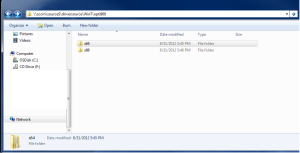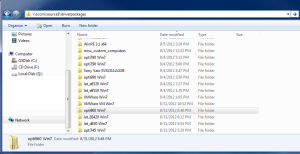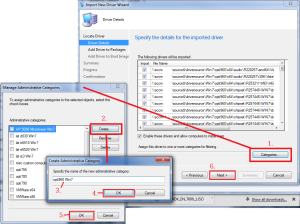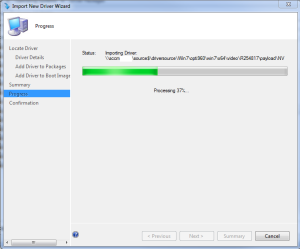This is a quick post about making driver packages in SCCM 2012. When making driver packages, organization is key.
Folder Layout
- Your default folder layout for SCCM should look something like this, \\Sccm\source$. The “source” folder should contain all of your information such as software packages, drivers and updates.
- Make two folders in your source directory, one called “driversource” and the other called “driverpackages”. In the end it will look like this (ignore the other folders for now).

Driver Source
- Your “driversource” folder should contain a folder for each operating system you plan to use.

- Lets act like we are using a win7 machine. Inside the “Win7” folder you should have a folder for each machine that will need drivers.

- Today we will be using the “Optiplex 960” or Opti960. Make a folder and call it “opti960”. Make two subfolders for named “x64” and “x86”.

- Alright in our “x64” folder, there should be a folder for each driver to be installed. All audio drivers should be inside a folder called “audio”, chipset drivers in a “chipset”…etc. It should look something like this.

- Try and keep these folders organized, if you do not, you may have to completely re-make this driver source folder in the future.
Driver Package
- Most of the work for this is done in SCCM. The only thing we have to do is create a folder for our “opti960” computer. Make a subfolder in \\sccm\source$\driverpackages called “opti960 Win7”.

Import Drivers and make driver packages
- Open “Software Library” and expand the “Operating Systems Folder”. Right click on “Drivers” and click “Import Driver”.

- A menu named “Import New Driver Wizard” will appear. Input the source folder of the driver your trying to import.

- Note: This step is very important, ensure you make a category for each type of computer! At the bottom of the “Driver Details” menu, click the “Categories…” button. This will pop a small menu named “Manage Administrative Categories”, click the “Create” button. Specify the name of your new driver, and go to the next step.

- At the bottom of the “Add Driver to Packages” menu, click the “New Package” button. In the menu that appears, assign the driver package a name and path to driver package.

- Hit next and the import will start.

- The wizard will look like this is it completed successfully.

- Now navigate to your \\sccm\source$\driverpackages\opti960 Win7 folder. Your folder should look something like this.

- You should be done!
Please leave any questions, concerns or problems!

Jesse
August 27, 2013 at 6:19 pm
Do you have to keep the drivers in the source folder? Can we delete them from the source after importing?
Quotie
June 11, 2014 at 10:32 am
Thanks for the goog description how to handle drivers and driver packages!
Unfortunately we have not such a good folder organization, which make it easier to understand the purpose of each folder.
Can you give some advice how to reorganize the folders without destroying the functionality of the existing
OS deployment and driver implementation… Help would be very appreciated!
win1337ist
June 17, 2014 at 3:01 am
Sure. Here is a good layout.
\\your-sccm-server\ccmSource\
This will be your folder layout inside the directory above.
1. Apps (applications related to sccm)
2. Boot Images
3. DriverPackages
4. DriverSource (where you put your .inf driver files)
5. images
6. OSCustimization
7. OSsource
8. packages
9. temp
10. Updates
Hope this helps.
Mohtasham Mokhtar
March 18, 2015 at 6:54 am
Great article. Great help to me…… Thanks a Lot
selim atmaca
March 17, 2016 at 2:30 pm
Thanks for this clear article